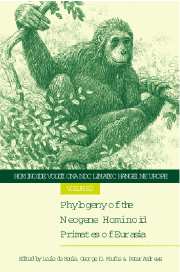 Hominoid Evolution and Climatic Change in Europe
Hominoid Evolution and Climatic Change in Europe Book contents
- Frontmatter
- Contents
- List of Contributors
- Acknowledgements: The European Science Foundation
- PART I: Chronology and environment
- PART II: Methods and phylogeny
- 3 Computer-assisted morphometry of hominoid fossils: the role of morphometric maps
- 4 Comparative analysis of the iliac trabecular architecture in extant and fossil primates by means of digital image processing techniques: implications for the reconstruction of fossil locomotor behaviours
- 5 Dental microwear and diet in Eurasian Miocene catarrhines
- 6 How reliable are current estimates of fossil catarrhine phylogeny? An assessment using extant great apes and Old World monkeys
- 7 Cranial discrete variation in the great apes: new prospects in palaeoprimatology
- PART III Miocone hominoids: function and phylogeny
- Index
4 - Comparative analysis of the iliac trabecular architecture in extant and fossil primates by means of digital image processing techniques: implications for the reconstruction of fossil locomotor behaviours
from PART II: Methods and phylogeny
Published online by Cambridge University Press: 06 January 2010
- Frontmatter
- Contents
- List of Contributors
- Acknowledgements: The European Science Foundation
- PART I: Chronology and environment
- PART II: Methods and phylogeny
- 3 Computer-assisted morphometry of hominoid fossils: the role of morphometric maps
- 4 Comparative analysis of the iliac trabecular architecture in extant and fossil primates by means of digital image processing techniques: implications for the reconstruction of fossil locomotor behaviours
- 5 Dental microwear and diet in Eurasian Miocene catarrhines
- 6 How reliable are current estimates of fossil catarrhine phylogeny? An assessment using extant great apes and Old World monkeys
- 7 Cranial discrete variation in the great apes: new prospects in palaeoprimatology
- PART III Miocone hominoids: function and phylogeny
- Index
Summary
Introduction
Among the extant mammals, primates display a great diversity of postural and locomotor behaviours. In an evolutionary perspective, this variation relates to their adaptive ability to exploit a full range of arboreal and terrestrial substrates (Jouffroy et al., 1990; Hunt et al., 1996). Principal primate locomotor modes include arboreal and terrestrial quadrupedalism, vertical clinging and leaping, saltation, suspensory climbing, brachiation, knuckle and fist-walking quadrupedalism, and bipedalism (Gebo, 1996). These varied locomotor patterns result in specific types of limb use which rely on a number of anatomical and biomechanical musculoskeletal specialisations (Conroy, 1990; Fleagle, 1999).
Following the principle of uniformitarianism, the reconstruction of body postures and modes of locomotion in fossil taxa is primarily based on the comparative analysis of external bone shape, size and proportions with the respective skeletal elements of living forms. Despite its obvious – but inescapable – intrinsic limits (Preuschoft, 1975), correlations between bony morphology and positional/locomotor behaviours ‘are constantly being tested and refined by experimental studies that permit a clearer understanding of the biomechanical and physiological mechanisms of primate evolution’ (Fleagle, 1999: 298).
In the last few years, there has been a growing interest for potential functional analysis and interpretation of fossil trabecular bone patterns, a previously underexploited tool for various aspects of vertebrate paleobiology. As ‘living bones modify their structure at gross, tissue, and molecular levels in response to the force patterns acting on them … the preserved structure of fossil bones may contain direct information on the forces that may have been experienced during life’ (Thomason, 1995: 249).
- Type
- Chapter
- Information
- Hominoid Evolution and Climatic Change in EuropePhylogeny of the Neogene Hominoid Primates of Eurasia, pp. 60 - 101Publisher: Cambridge University PressPrint publication year: 2001
- 7
- Cited by


